fuel HONDA CLARITY FUEL CELL 2017 Owner's Manual (in English)
[x] Cancel search | Manufacturer: HONDA, Model Year: 2017, Model line: CLARITY FUEL CELL, Model: HONDA CLARITY FUEL CELL 2017Pages: 527, PDF Size: 17.62 MB
Page 1 of 527
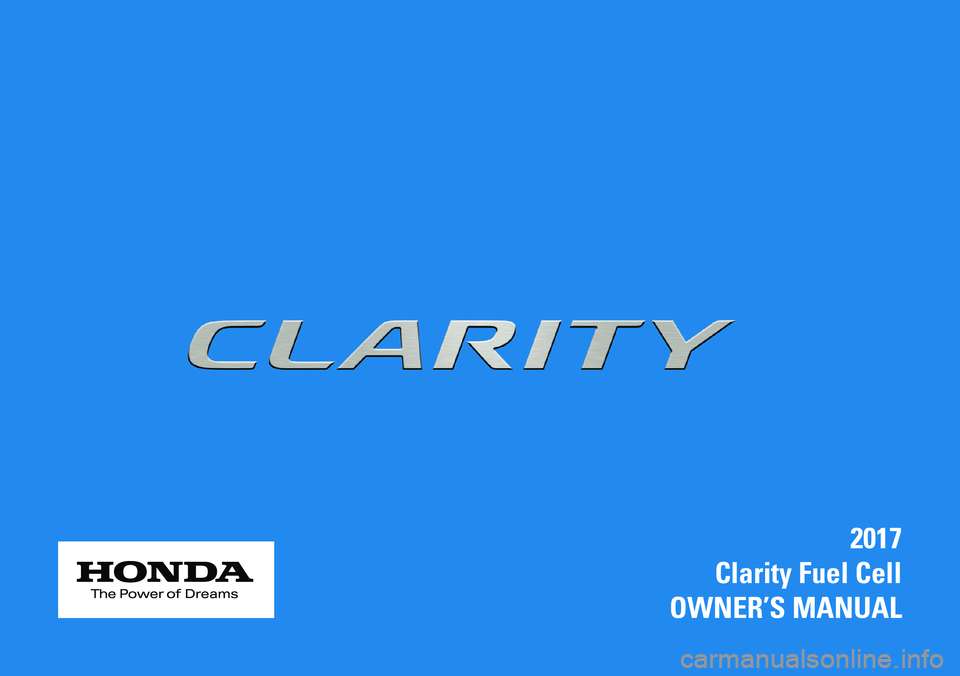
2017
Clarity Fuel Cell
OWNER’S MANUAL
Page 3 of 527
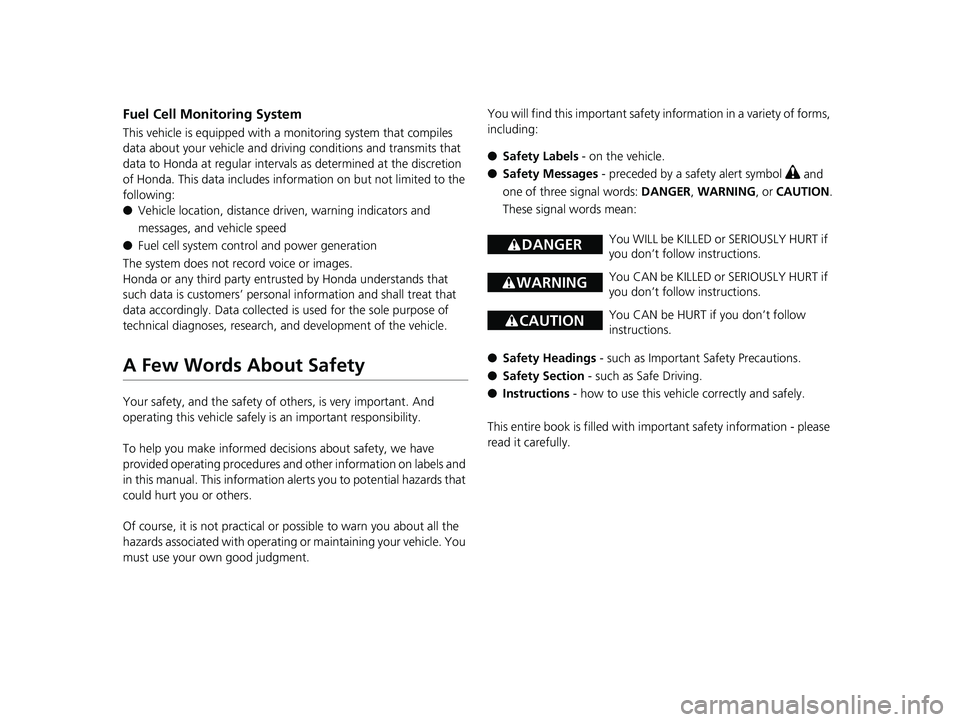
Fuel Cell Monitoring System
This vehicle is equipped with a monitoring system that compiles
data about your vehicle and driving conditions and transmits that
data to Honda at regular intervals as determined at the discretion
of Honda. This data includes information on but not limited to the
following:
● Vehicle location, distance driven, warning indicators and
messages, and vehicle speed
● Fuel cell system control and power generation
The system does not record voice or images.
Honda or any third party entrusted by Honda understands that
such data is customers’ personal information and shall treat that
data accordingly. Data collected is used for the sole purpose of
technical diagnoses, research, and development of the vehicle.
A Few Words About Safety
Your safety, and the safety of others, is very important. And
operating this vehicle safely is an important responsibility.
To help you make informed decisions about safety, we have
provided operating procedures and other information on labels and
in this manual. This information alerts you to potential hazards that
could hurt you or others.
Of course, it is not practical or possible to warn you about all the
hazards associated with operating or maintaining your vehicle. You
must use your own good judgment. You will find this impo
rtant safety information in a variety of forms,
including:
● Safety Labels - on the vehicle.
● Safety Messages - preceded by a safety alert symbol
3 and
one of three signal words: DANGER, WARNING , or CAUTION .
These signal words mean:
● Safety Headings - such as Important Safety Precautions.
● Safety Section - such as Safe Driving.
● Instructions - how to use this vehi cle correctly and safely.
This entire book is filled with important safety information - please
read it carefully.
3 DANGERYou WILL be KILLED or SERIOUSLY HURT if
you don’t follow instructions.
3 WARNINGYou CAN be KILLED or SERIOUSLY HURT if
you don’t follow instructions.
3CAUTIONYou CAN be HURT if you don’t follow
instructions.
17 CLARITY FCV PPO-31TRT6000.book 1 ページ 2016年10月27日 木曜日 午後3時11分
Page 4 of 527
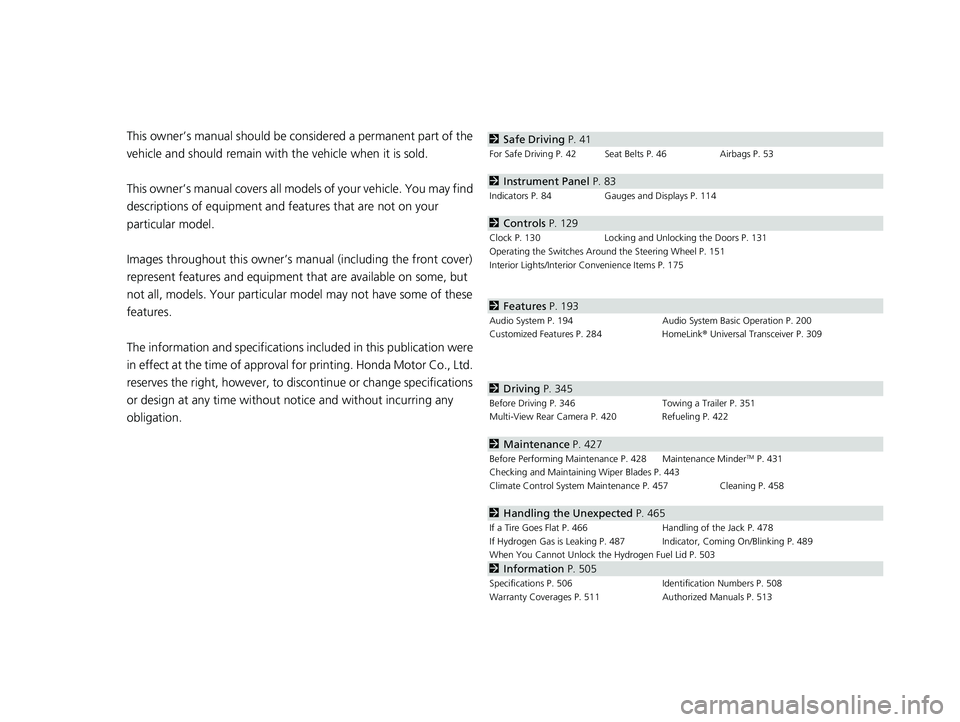
Contents
This owner’s manual should be considered a permanent part of the
vehicle and should remain with the vehicle when it is sold.
This owner’s manual covers all models of your vehicle. You may find
descriptions of equipment and features that are not on your
particular model.
Images throughout this owner’s manu al (including the front cover)
represent features and equipment that are available on some, but
not all, models. Your particular mo del may not have some of these
features.
The information and specifications in cluded in this publication were
in effect at the time of approval for printing. Honda Motor Co., Ltd.
reserves the right, however, to discontinue or change specifications
or design at any time without notice and without incurring any
obligation.2 Safe Driving P. 41
For Safe Driving P. 42 Seat Belts P. 46 Airbags P. 53
2Instrument Panel P. 83
Indicators P. 84 Gauges and Displays P. 114
2Controls P. 129
Clock P. 130 Locking and Unlocking the Doors P. 131
Operating the Switches Ar ound the Steering Wheel P. 151
Interior Lights/Interior Convenience Items P. 175
2 Features P. 193
Audio System P. 194 Audio System Basic Operation P. 200
Customized Features P. 284 HomeLink® Universal Transceiver P. 309
2 Driving P. 345
Before Driving P. 346 Towing a Trailer P. 351
Multi-View Rear Camera P. 420 Refueling P. 422
2 Maintenance P. 427
Before Performing Maintenance P. 428 Maintenance MinderTM P. 431
Checking and Maintaining Wiper Blades P. 443
Climate Control System Main tenance P. 457 Cleaning P. 458
2Handling the Unexpected P. 465
If a Tire Goes Flat P. 466 Handling of the Jack P. 478
If Hydrogen Gas is Leaking P. 487 Indicator, Coming On/Blinking P. 489
When You Cannot Unlock the Hydrogen Fuel Lid P. 503
2 Information P. 505
Specifications P. 506 Identification Numbers P. 508
Warranty Coverages P. 511 Authorized Manuals P. 513
17 CLARITY FCV PPO-31TRT6000.book 2 ページ 2016年10月27日 木曜日 午後3時11分
Page 5 of 527
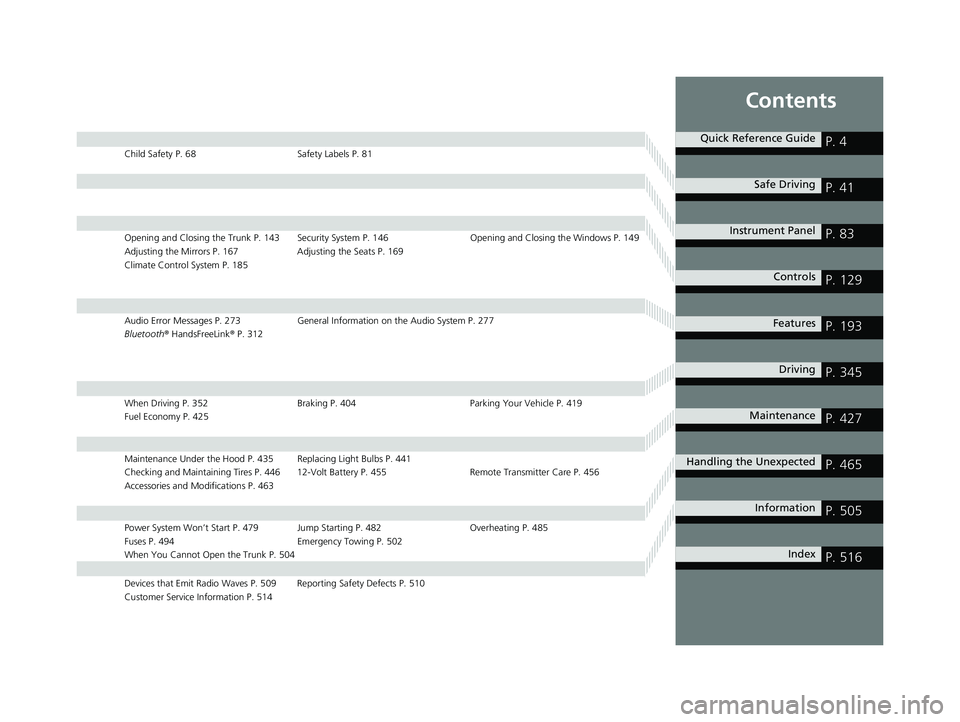
Contents
Child Safety P. 68Safety Labels P. 81
Opening and Closing the Trunk P. 143 Security System P. 146 Opening and Closing the Windows P. 149
Adjusting the Mirrors P. 167 Adjusting the Seats P. 169
Climate Control System P. 185
Audio Error Messages P. 273 General Information on the Audio System P. 277
Bluetooth® HandsFreeLink ® P. 312
When Driving P. 352 Braking P. 404Parking Your Vehicle P. 419
Fuel Economy P. 425
Maintenance Under the Hood P. 435 Replacing Light Bulbs P. 441
Checking and Maintaining Tires P. 446 12-Volt Battery P. 455 Remote Transmitter Care P. 456
Accessories and Modifications P. 463
Power System Won’t Start P. 479 Jump Starting P. 482 Overheating P. 485
Fuses P. 494 Emergency Towing P. 502
When You Cannot Open the Trunk P. 504
Devices that Emit Radio Waves P. 509 Reporting Safety Defects P. 510
Customer Service Information P. 514
Quick Reference GuideP. 4
Safe DrivingP. 41
Instrument PanelP. 83
ControlsP. 129
FeaturesP. 193
DrivingP. 345
MaintenanceP. 427
Handling the UnexpectedP. 465
InformationP. 505
IndexP. 516
17 CLARITY FCV PPO-31TRT6000.book 3 ページ 2016年10月27日 木曜日 午後3時11分
Page 8 of 527
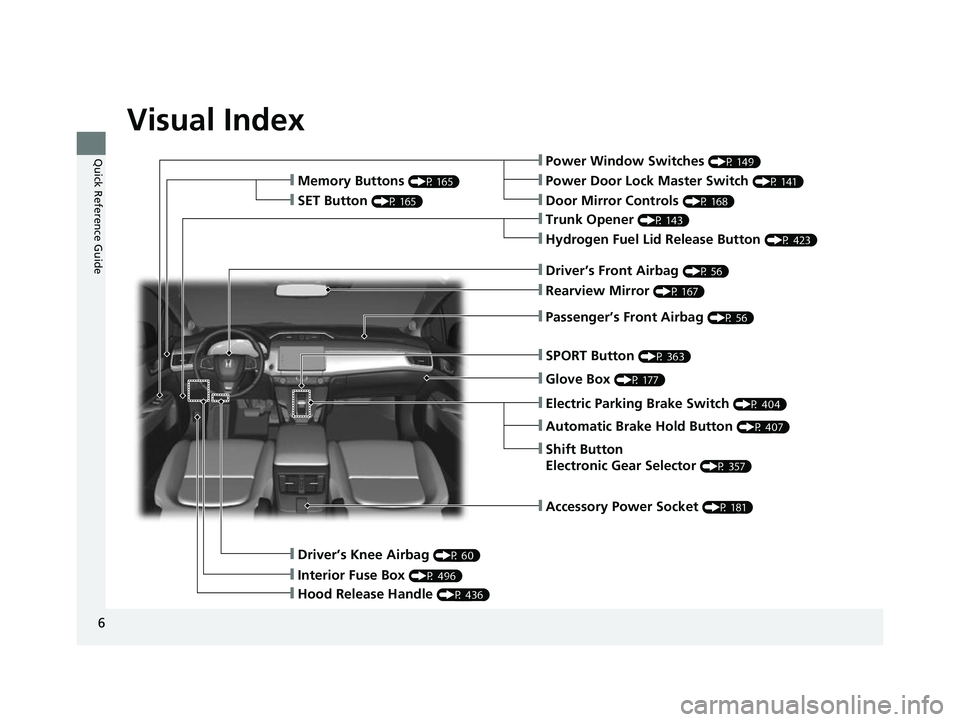
Visual Index
6
Quick Reference Guide❙Power Window Switches (P 149)
❙Trunk Opener (P 143)
❙Driver’s Knee Airbag (P 60)
❙Door Mirror Controls (P 168)
❙Power Door Lock Master Switch (P 141)
❙Hydrogen Fuel Lid Release Button (P 423)
❙Memory Buttons (P 165)
❙SET Button (P 165)
❙Interior Fuse Box (P 496)
❙Automatic Brake Hold Button (P 407)
❙Driver’s Front Airbag (P 56)
❙Passenger’s Front Airbag (P 56)
❙Rearview Mirror (P 167)
❙SPORT Button (P 363)
❙Glove Box (P 177)
❙Electric Parking Brake Switch (P 404)
❙Shift Button
Electronic Gear Selector
(P 357)
❙Accessory Power Socket (P 181)
❙Hood Release Handle (P 436)
17 CLARITY FCV PPO-31TRT6000.book 6 ページ 2016年10月27日 木曜日 午後3時11分
Page 10 of 527
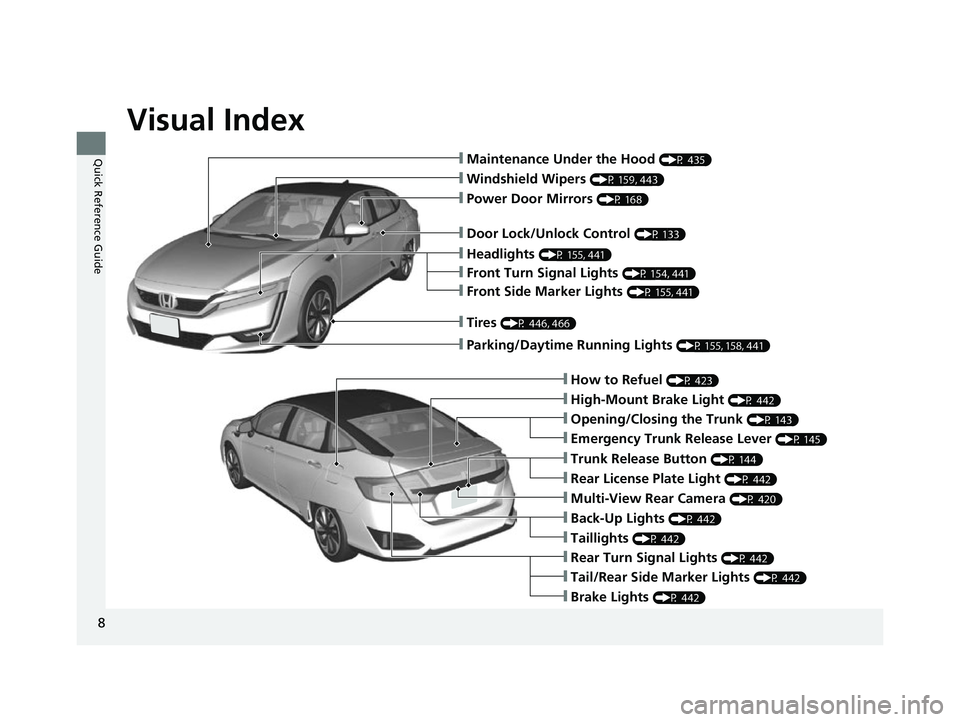
Visual Index
8
Quick Reference Guide❙Maintenance Under the Hood (P 435)
❙Windshield Wipers (P 159, 443)
❙Tires (P 446, 466)
❙Door Lock/Unlock Control (P 133)
❙Power Door Mirrors (P 168)
❙Headlights (P 155, 441)
❙Front Side Marker Lights (P 155, 441)
❙Front Turn Signal Lights (P 154, 441)
❙How to Refuel (P 423)
❙High-Mount Brake Light (P 442)
❙Emergency Trunk Release Lever (P 145)
❙Opening/Closing the Trunk (P 143)
❙Tail/Rear Side Marker Lights (P 442)
❙Brake Lights (P 442)
❙Rear Turn Signal Lights (P 442)
❙Back-Up Lights (P 442)
❙Taillights (P 442)
❙Trunk Release Button (P 144)
❙Rear License Plate Light (P 442)
❙Multi-View Rear Camera (P 420)
❙Parking/Daytime Running Lights (P 155, 158, 441)
17 CLARITY FCV PPO-31TRT6000.book 8 ページ 2016年10月27日 木曜日 午後3時11分
Page 11 of 527
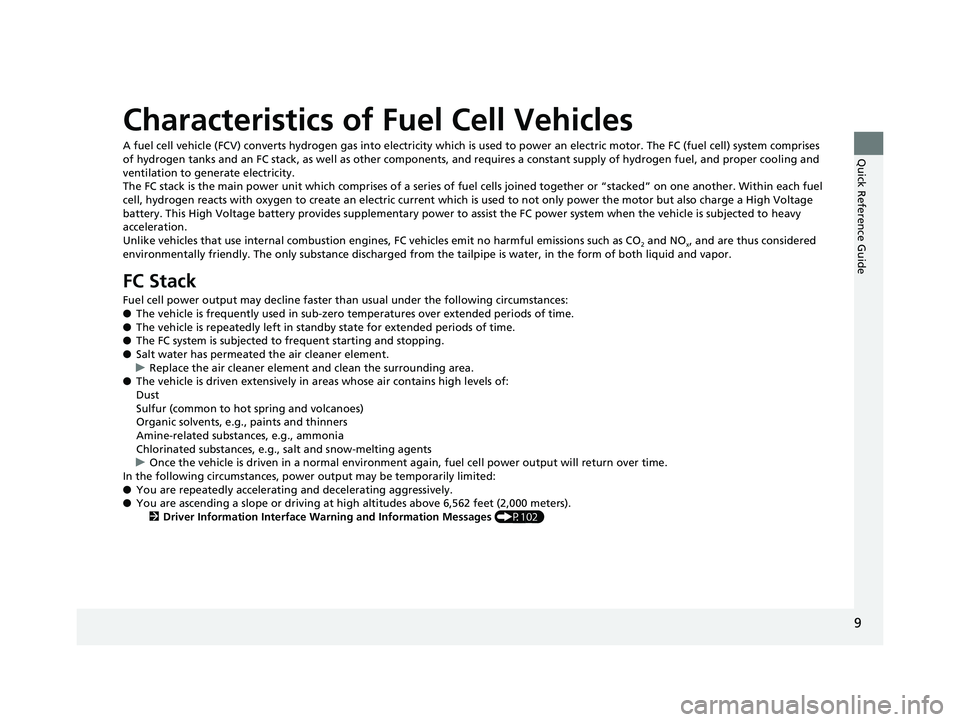
9
Quick Reference Guide
Characteristics of Fuel Cell Vehicles
A fuel cell vehicle (FCV) converts hydrogen gas into electricity which is used to power an electric motor. The FC (fuel cell) system comprises
of hydrogen tanks and an FC stack, as well as other components, and requires a constant supply of hydrogen fuel, and proper cooling and
ventilation to generate electricity.
The FC stack is the main power unit which comprises of a series of fuel cells joined together or “stacked” on one another. With in each fuel
cell, hydrogen reacts with oxygen to create an electric current whic h is used to not only power the motor but also charge a High Voltage
battery. This High Voltage battery provides supplementary power to assist the FC power system when the vehicle is subjected to heavy
acceleration.
Unlike vehicles that use internal combustion engines, FC vehicles emit no harmful emissions such as CO
2 and NOx, and are thus considered
environmentally friendly. The only substa nce discharged from the tailpipe is water, in the form of both liquid and vapor.
FC Stack
Fuel cell power output may decline faster th an usual under the following circumstances:
● The vehicle is frequently used in sub-zero temperatures over extended periods of time.
● The vehicle is repeatedly left in stand by state for extended periods of time.
● The FC system is subjected to frequent starting and stopping.
● Salt water has permeated the air cleaner element.
u Replace the air cleaner element and clean the surrounding area.
● The vehicle is driven extensively in areas whose air contains high levels of:
Dust
Sulfur (common to hot spring and volcanoes)
Organic solvents, e.g., paints and thinners
Amine-related substa nces, e.g., ammonia
Chlorinated substances, e.g., salt and snow-melting agents
u Once the vehicle is driven in a normal environment again, fuel cell power output will return over time.
In the following circumstances, power output may be temporarily limited:
● You are repeatedly accelerating and decelerating aggressively.
● You are ascending a slope or driving at high altitudes above 6,562 feet (2,000 meters).
2 Driver Information Interface Wa rning and Information Messages (P102)
17 CLARITY FCV PPO-31TRT6000.book 9 ページ 2016年10月27日 木曜日 午後3時11分
Page 12 of 527
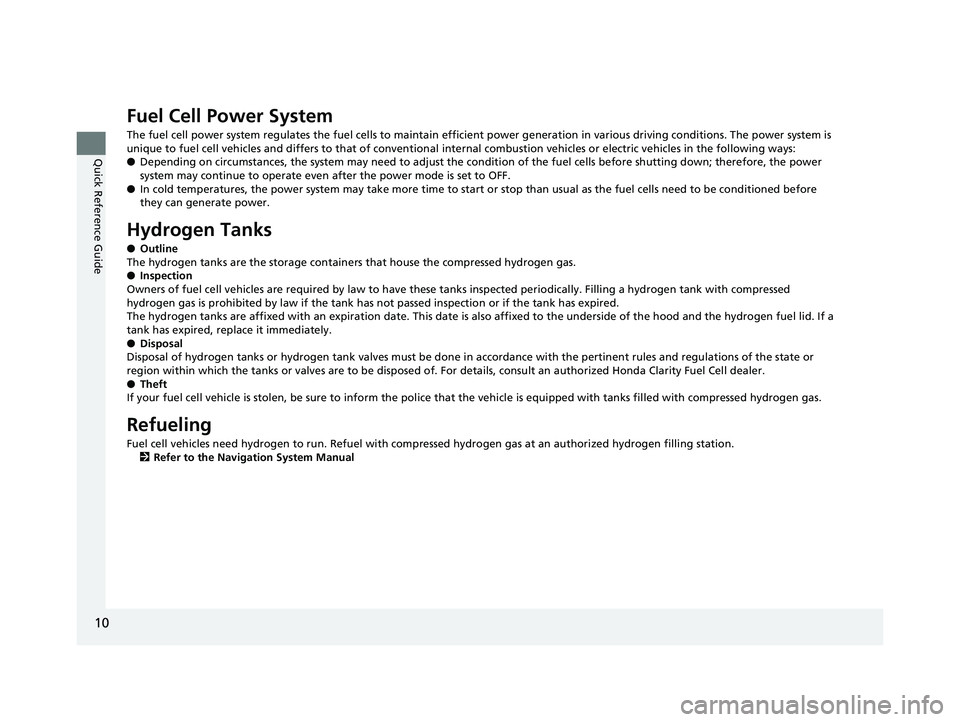
10
Quick Reference Guide
Fuel Cell Power System
The fuel cell power system regulates the fuel cells to maintain efficient power generation in various driving conditions. The power system is
unique to fuel cell vehicles and differs to that of conventional internal combustion vehicles or electric vehicles in the following ways:
● Depending on circumstances, the system may n eed to adjust the condition of the fuel cells before shutting down; therefore, the power
system may continue to operate even after the power mode is set to OFF.
● In cold temperatures, the power system may take more time to sta rt or stop than usual as the fuel cells need to be conditioned before
they can generate power.
Hydrogen Tanks
● Outline
The hydrogen tanks are the storage containe rs that house the compressed hydrogen gas.
● Inspection
Owners of fuel cell vehicles are required by law to have these tanks inspected periodically. Filling a hydrogen tank with compr essed
hydrogen gas is prohibited by law if the tank has not passed inspection or if the tank has expired.
The hydrogen tanks are affixed with an expiration date. This date is also affixed to the underside of the hood and the hydrogen fuel lid. If a
tank has expired, replace it immediately.
● Disposal
Disposal of hydrogen tanks or hydrogen tank valves must be done in accordance with the pertinen t rules and regulations of the state or
region within which the tanks or valves are to be disposed of. For details, consult an authorized Honda Clarity Fuel Cell deale r.
● Theft
If your fuel cell vehicle is stolen, be sure to inform the polic e that the vehicle is equipped with tanks filled with compresse d hydrogen gas.
Refueling
Fuel cell vehicles need hydrogen to run. Refuel with compressed hydrogen gas at an authorized hydrogen filling station.
2 Refer to the Navigation System Manual
17 CLARITY FCV PPO-31TRT6000.book 10 ページ 2016年10月27日 木曜日 午後3時 11分
Page 13 of 527
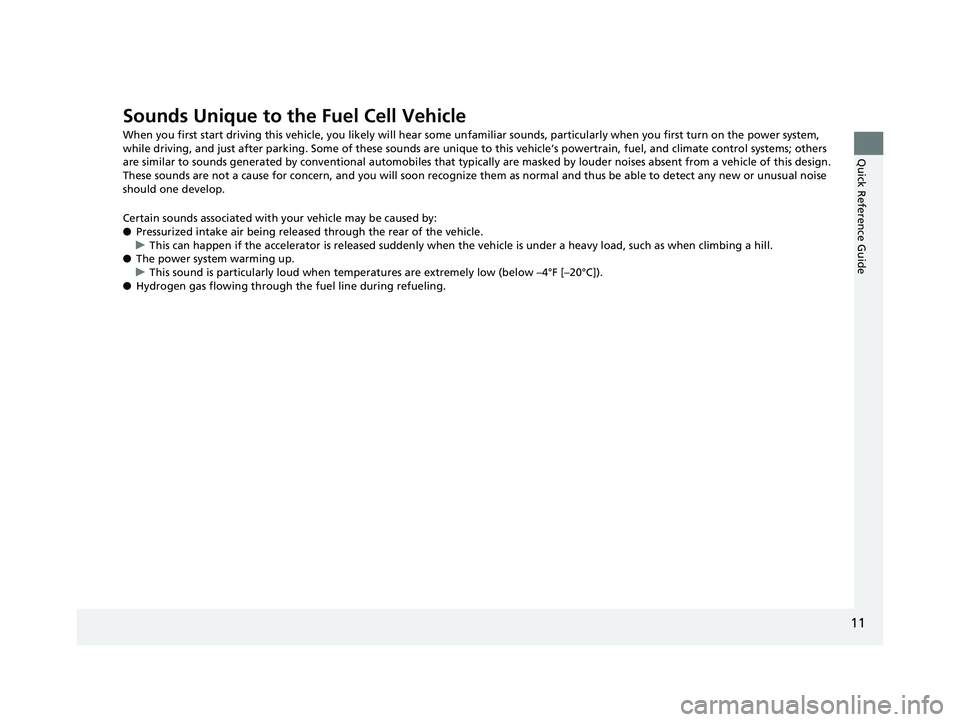
11
Quick Reference Guide
Sounds Unique to the Fuel Cell Vehicle
When you first start driving this vehicle, you likely will hear some unfamiliar sounds, particularly when you first turn on the power system,
while driving, and just after parking. Some of these sounds are unique to this vehicle’s powertrain, fuel, and climate control systems; others
are similar to sounds generated by conventional automobiles that typically are masked by louder noises absent from a vehicle of this design.
These sounds are not a cause for concern, and you will soon recognize them as normal and thus be able to detect any new or unus ual noise
should one develop.
Certain sounds associated with your vehicle may be caused by:
● Pressurized intake air being released through the rear of the vehicle.
u This can happen if the accelerator is released suddenly when the vehicle is under a heavy load, such as when climbing a hill.
● The power system warming up.
u This sound is particularly loud when temperat ures are extremely low (below –4°F [–20°C]).
● Hydrogen gas flowing through the fuel line during refueling.
17 CLARITY FCV PPO-31TRT6000.book 11 ページ 2016年10月27日 木曜日 午後3時 11分
Page 14 of 527
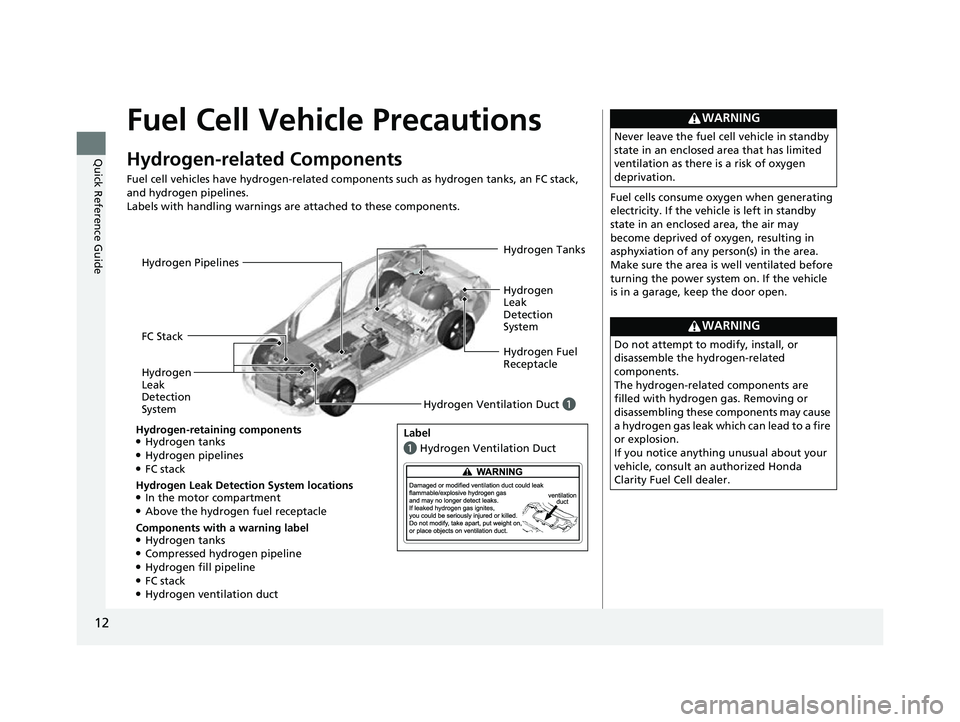
12
Quick Reference Guide
Fuel Cell Vehicle Precautions
Hydrogen-related Components
Fuel cell vehicles have hydrogen-related components such as hydrogen tanks, an FC stack,
and hydrogen pipelines.
Labels with handling warnings are attached to these components.
Hydrogen
Leak
Detection
System
FC StackHydrogen
Leak
Detection
System
Hydrogen Fuel
Receptacle Hydrogen Tanks
Hydrogen Pipelines
Hydrogen-retaining components
●Hydrogen tanks●Hydrogen pipelines●FC stack
Components with a warning label
●Hydrogen tanks●Compressed hydrogen pipeline●Hydrogen fill pipeline●FC stack●Hydrogen ventilation duct
Hydrogen Leak Detection System locations
●In the motor
compartment●Above the hydrogen fuel receptacle Hydrogen Ventilation Duct
a
Label
a Hydrogen Ventilation Duct
Fuel cells consume oxygen when generating
electricity. If the vehicle is left in standby
state in an enclosed area, the air may
become deprived of oxygen, resulting in
asphyxiation of any person(s) in the area.
Make sure the area is well ventilated before
turning the power system on. If the vehicle
is in a garage, keep the door open.
WARNING
Never leave the fuel cell vehicle in standby
state in an enclosed area that has limited
ventilation as there is a risk of oxygen
deprivation.
WARNING
Do not attempt to modify, install, or
disassemble the hydrogen-related
components.
The hydrogen-related components are
filled with hydrogen gas. Removing or
disassembling these components may cause
a hydrogen gas leak which can lead to a fire
or explosion.
If you notice anything unusual about your
vehicle, consult an authorized Honda
Clarity Fuel Cell dealer.
17 CLARITY FCV PPO-31TRT6000.book 12 ページ 2016年10月27日 木曜日 午後3時 11分